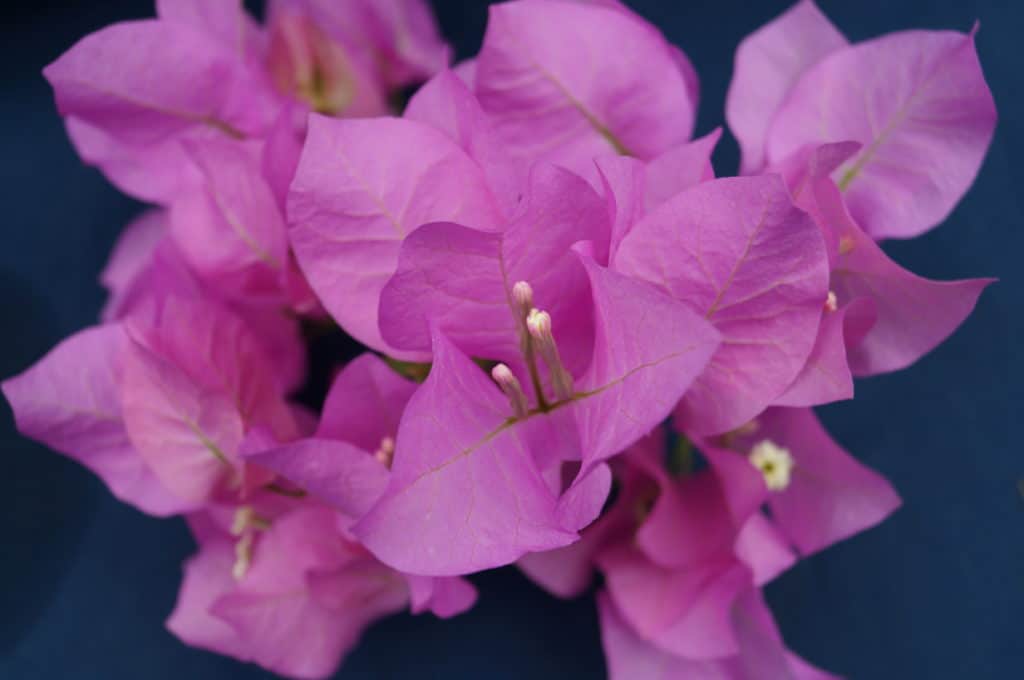
Bougainvillea are native to central and South America, but are now found in most warm countries around the world.
How many varieties of bougainvillea are there?
There is no definite answer, but most experts agree there are more than 300 varieties of bougainvillea. They include the vine-like climbing bougainvillea, dwarf varieties (ideal for containers), bushy bougainvillea and even ground cover bougainvillea varieties. The colour spectrum of bougainvillea ranges from white through pale apricot to magenta and deep red.
Does bougainvillea only grow in greenhouses in the UK?
The short answer is “yes”, although if the plants are grown in a container you can move them to a sunny spot in the garden during the summer months. Bougainvillea are happiest in a sunny conservatory, safe from frost, tied to a firm trellis, with their roots in a well-drained, slightly acid soil. Some have reported success growing the hardier varieties of bougainvillea outdoors against walls or in protected porches in Cornwall and the Scilly Isles where winters are less harsh.
Bougainvillea also lend themselves well to being cultivated as Bonsai trees, kept indoors.
What time of year does bougainvillea bloom in the UK?
Kept in the right (warm) conditions bougainvillea are evergreen and generally produce their vibrant bracts (commonly thought to be flowers) from early summer through to autumn. In a sunny, heated greenhouse or conservatory bougainvillea have, however, been known to bloom for most of the year.
How much water do bougainvillea need?
The rule to follow is when in the bougainvillea is in its growth phase and while blooming, water well periodically, allowing the soil to dry out somewhat in between (though it should remain slightly damp). During the dormant phase after the bougainvillea has stopped flowering (which would usually be autumn to spring), water very sparingly.
Do bougainvillea need feeding?
During the vegetative growth phase – in early spring – a regular dose of a high nitrogen fertilizer every week will ensure a growth spurt of leaves and stems. Once the colourful bougainvillea bracts (and flowers) start to appear a weekly dose of high potash fertilizer will encourage them to keep developing. If the bougainvillea leaves start to yellow the plant can be treated with Epsom salts.
What type of soil is best for bougainvillea?
Bougainvillea should be planted in a well-drained soil with a ph of 5.5-6.5. If planting a bougainvillea in a container, ensure the potting mixture does not have high peat levels or retain too much water, because this could cause the fine root system to rot.
How often should a bougainvillea be re-potted?
Containerised bougainvillea plants enjoy being pot-bound, so they will bloom happily in the same pot for several years before requiring re-potting into a slightly larger pot. The bougainvillea root system is very fragile, so try to disturb the roots as little as possible when re-potting.
Can you grow a bougainvillea from a cutting?
Indeed you can! During the bougainvillea’s growth spurt in early spring (before flowering) take a stem cutting about six inches long from below a growing tip, using a sharp, sterile knife. Remove all the leaves (except for a few at the top). Pot the bougainvillea cutting into a small pot containing good quality compost mixed with some grit or vermiculite for good drainage. Before potting dip the bougainvillea stem into some rooting hormone powder. Keep in a warm, humid atmosphere, watering with a fine spray to keep the soil moist but not saturated. The bougainvillea cutting can be planted out once fully rooted with new growth apparent on the stem.
What pests attack bougainvillea plants?
Bougainvillea plants are largely resistant to pests and disease, but they may be attacked by aphids if growing outside during the summer. Red spider and scale are sometimes found on bougainvillea plants in greenhouses and conservatories. All these problems can be treated with off-the-shelf pesticides.
When should bougainvillea be pruned?
Because they tend to grow very large unless controlled, bougainvillea plants need pruning or trimming to shape annually. Pruning is best done after the flowering season – in late autumn – or in early spring before new growth begins.
